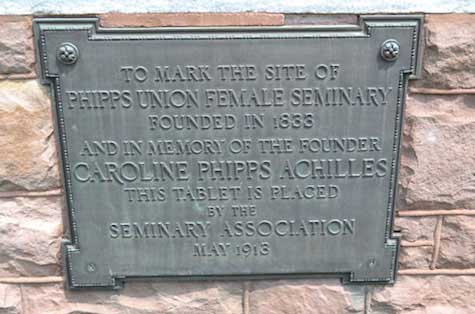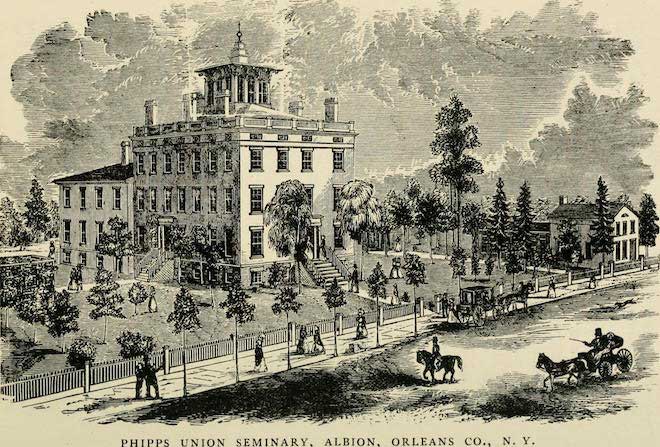Seminary in Albion showed commitment to higher education for women in 1800s
“Overlooked Orleans” – Vol. 4, No. 11
ALBION – Over 200 years ago, Caroline Phipps was born near Rome, New York on March 2, 1812 to Joseph and Mary Eames Phipps. Arad Thomas writes in the Pioneer History of Orleans County that her “early education was superintended by her father with more than ordinary care at home, though she had the advantages of the best private schools and of the district schools in the vicinity.”
After her father relocated the family to Barre, Caroline attended school at Eagle Harbor before starting her career in teaching at the young age of 14 in a one-room schoolhouse at Gaines Basin. It is presumed, based on available information, that Phipps was the school teacher while Charles Anderson Dana was attending the log schoolhouse (Overlooked Orleans: v.1, no.13).
A passionate educator even at a young age, Phipps enrolled in the Gaines Academy at the age of 20 and eventually attended the Nichols Ladies’ School at Whitesboro, New York. It was approximately a year after her enrollment at the Gaines Academy that she proposed the idea of an all-female educational institution by circulating a letter around Albion. The notice stated her intention to build a female seminary and sought support from prominent citizens to assist with the funding of the school. The proposal was met with opposition from the area’s leading residents, many who favored a school for boys and girls.

Photo by Tom Rivers: This historical marker was dedicated more than 100 years ago in May 1913. It is on the County Clerk’s Building. The alumni of the Phipps Union Seminary had the marker put on a sandstone wall next to the front steps of the building.
Caroline Phipps remained committed to the idea of an all-female institution of higher learning, as stated by Arad Thomas, “acting on a favorite theory…that it is better to teach boys and girls in separate schools…” She set forth a plan and sought support in raising the necessary funds to erect an edifice in which to house this new educational endeavor.
In Landmarks of Orleans County, Isaac Signor published a list of those who generously gave in support of the institution, the largest donors including Roswell S. Burrows, Alexis Ward, and Freeman Clarke, each committing $200 to the cause. Other donors included Elizur Hart, Orson Nichoson, and Norman Bedell, the father of Grace Bedell.
Totaling nearly $4,500, the amount was put towards the construction of a four-story brick building approximately 40 feet by 60 feet and costing a total of $14,000. The institution opened in January of 1837 with 100 boarders and 100 day scholars, according to Signor. Young women from across the country traveled to Albion to attend Phipps’ Female Union Seminary, the second institution of its kind in the United States (after the Willard Seminary in Troy, NY). In 1839, Caroline married Henry L. Achilles of Rochester (Overlooked Orleans: v.2, no.20) and the responsibility of leading the institution was passed to her younger sister, Sophronia, who remained as principal until her marriage in 1847 to Dr. J. L. Hodge of Brooklyn, New York.
The following year the seminary was sold to Rev. Frederick James, who remained the head of the institution for a very brief period. Almost immediately after the sale was finalized, the seminary’s enrollment dropped from 100 students to less than 40. The board of directors, frustrated and dismayed, pleaded for Henry and Caroline to return to Albion from Boston to retake control of the operation. With reluctance the couple agreed to take the reins of the institution and Caroline made quick work of rebuilding the seminary’s reputation. The following year was marked by a spike in enrollment, which led to the construction of a wood-frame addition on the north end of the building in 1851.
A small booklet entitled Sketches of the Village of Albion reads, “standing on the highest land in the village, the Seminary buildings, and the numerous trees around them, are among the first objects noted by the traveler on entering Albion in any direction…The course of instruction in this school comprises all branches of useful and ornamental education usually taught in the best Female Seminaries in this country. An average number of ten teachers are employed, besides the services of Mr. and Mrs. Achilles.”
Their oversight of the seminary was only temporary, as Thomas writes, “Tired and worn down by the harassing cares, anxieties and labor of superintending so large an establishment and school, so many years, in 1866 Mrs. Achilles reluctantly consented to transfer her dearly cherished Seminary again to strangers.” Rev. George A. Starkweather assumed control of the institution after purchasing it at a price of $20,000 (approx. $325,000 today).
Once again, the school suffered a similar fate as the first sale and the reputation of the institution was ruined by its new owner. The board pleaded for Henry and Caroline to retake control of the Seminary, to which Henry was fervently opposed. It was thanks to the encouragement of his wife that the seminary was yet again brought under the control of the Achilles family and provided with the opportunity to thrive. The vibrant and renowned school remained in operation until a series of fires occurred in the autumn of 1874 and the spring of 1875, which forced the Seminary to cease operation. The parcel of land was eventually purchased by the county, the original lot now occupied by the County Clerk’s Office.
Henry died on January 16, 1881 from an abscess and was interred with his first two wives at Mt. Hope Cemetery in Rochester; Caroline was buried with her family at Mt. Albion after her death ten days later on January 26, 1881.






































































